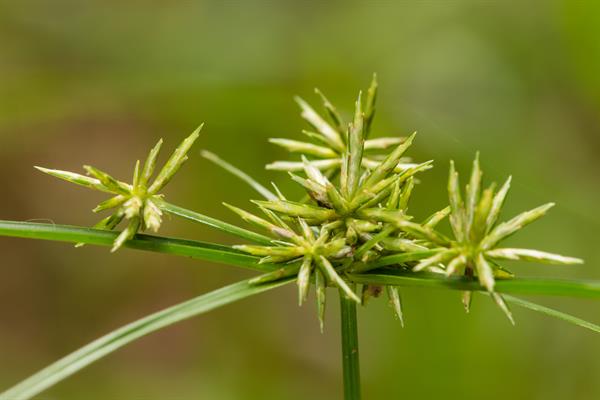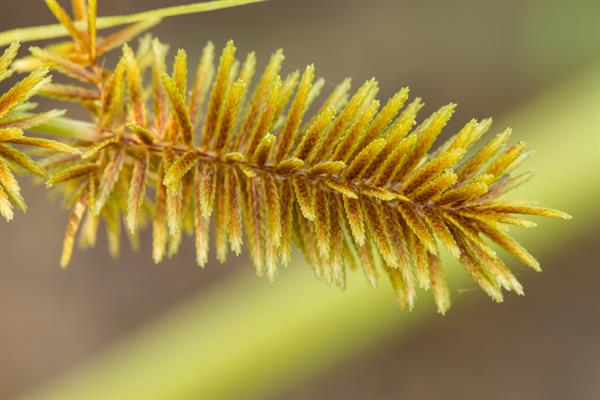
Contributed by John C. Kees, J. Richard Carter, and Alan S. Weakley
A genus of about 600-700 species, herbs, of tropical and warm temperate areas. The circumscription of Cyperus has been expanded recently to include a number of genera found to be phylogenetically embedded within it, notably (for our area), Kyllinga, Lipocarpha, Oxycaryum, and Remirea (Larridon et al. 2011a, 2011b, 2011c, 2014; Bauters et al. 2014; Reynders 2011). This treatment draws heavily on Tucker, Marcks, & Carter in FNA (2002b) and other sources for detailed measurements. Several of the major subgenera (Pycnostachys, Cyperus, Pycreus) used in the keys are not monophyletic as currently circumscribed (Reid 2016, Larridon et al. 2014).
Key advice:To facilitate field identification, characters which can be readily observed with a hand lens or in macro photos are emphasized in the key; however, a dissecting scope with magnification of 40-50× is useful for detailed examination of individual scales and achenes, and microscopic characters are often used as secondary characters and for closely related species. Mature fruiting material is required for reliable identification of Cyperus species. Because of the indeterminate growth of spikelets, florets can usually be found near the spikelet apex. The culm (main stem) in Cyperus species ranges from trigonous (triangular in cross-section, with flat or convex faces) or triquetrous (sharply triangular in cross-section, with concave faces), to nearly terete (circular in cross-section), and is terminated by a whorl of leaflike bracts, subtending an inflorescence of 1-many spikelets. Spikelets consist of 1-many floral scales (referred to as glumes in some treatments) arranged along a rachilla that may be winged; each floral scale subtends a single bisexual (usually) floret with perianth 0, stamens 1-3, and a pistil with a 2-3-branched style. Characters related to scale posture are based on fruiting material; in some species, particularly sect. Laxiglumi, scales are initially appressed and spread, the spikelet becoming compressed, as the achenes mature. Scales may be deciduous (falling from the rachilla at senescence with the achenes) or persistent (remaining attached to the rachilla); rachillas may be persistent (remaining attached to the plant) or deciduous (articulating at or near the base or below each scale). Scales have a thickened midrib that may be bicarinate (2-keeled) basally or project apically as a mucro, cusp, or awn, and 0-many lateral nerves (veins). Achene surfaces (at 40-50×) may be smooth, reticulate, papillose, or puncticulate (pitted); the achene may be sessile, short-stipitate, or have an enlarged spongy base; the style base may persist as a minute apiculus or longer beak. Cyperus often have highly branched inflorescences. Spikelets may be borne in spikes along an elongate rachis, or in digitate clusters or glomerulate or umbellate heads. These spikes, heads, or other clusters may be sessile or borne at the end of rays (pedunculate), in some species with 3 or 4 orders of branching. The plant base is often helpful for identification, as some species reproduce vegetatively from scaly, indurate rhizomes; slender, subterranean stolons, often terminated by tubers; proliferous spikelets; or enlarged, cormose culm bases.
Ref: Bauters et al. (2014); Bruhl (2002b) In Flora of North America Editorial Committee (2002b); Bruhl & Tucker (2002) In Flora of North America Editorial Committee (2002b); Bryson & Carter (1992); Bryson & Carter (1994); Bryson et al. (1996); Bryson et al. (1997); Bryson, Maddox, & Carter (2008); Carter (1988); Carter (1990); Carter (1993); Carter & Bryson (1991); Carter & Bryson (2000); Carter & Jarvis (1986); Carter & Jones (1997); Carter & Kral (1990); Carter & Mears (2000); Carter et al. (1996); Carter et al. (1999); Carter et al. (2016); Carter, Allen, & Lewis (2009); Carter, Baker, & Morris (2009); Carter, Bryson, & Lipscomb (1987); De Castro et al. (2015); Delahoussaye & Thieret (1967); Goetghebeur & Van den Borre (1989); Goetghebeur & Van den Borre (1989); Goetghebeur In Kubitzki (1998b); Jones, Wipff, & Carter (1996); Larridon et al. (2011a); Larridon et al. (2011b); Larridon et al. (2014); Lowe & Carter (2022c); Lowe & Carter (2023); McKenzie et al. (1998); Mohlenbrock (1959); Reid (2016); Reid et al. (2017); Reid, Carter, & Urbatsch (2014); Rosen et al. (2012); Rosen, Carter, & Bryson (2006); Schippers, Ter Borg, & Bos (1995); Tucker (1983); Tucker (1984); Tucker (1987); Tucker (1994); Tucker (2002a) In Flora of North America Editorial Committee (2002b); Tucker (2002b) In Flora of North America Editorial Committee (2002b); Tucker & Gandhi (2019); Tucker, Marcks, & Carter (2002) In Flora of North America Editorial Committee (2002b); Wipff & Jones (1994). Show full citations.
Hover over a shape, letter, icon, or arrow on the map for definition or see the legend. Data for arrows not developed for genera and families which may have species only occurring outside the flora area.
 © Keith Bradley | Cyperus flavicomus | Original Image ⭷
© Keith Bradley | Cyperus flavicomus | Original Image ⭷ © Keith Bradley | Cyperus iria | Original Image ⭷
© Keith Bradley | Cyperus iria | Original Image ⭷ © Keith Bradley | Cyperus difformis | Original Image ⭷
© Keith Bradley | Cyperus difformis | Original Image ⭷ © Paul Marcum | Cyperus squarrosus var. squarrosus source | Original Image ⭷
© Paul Marcum | Cyperus squarrosus var. squarrosus source | Original Image ⭷ © Keith Bradley | Cyperus flavicomus | Original Image ⭷
© Keith Bradley | Cyperus flavicomus | Original Image ⭷ © Gary P. Fleming | Cyperus hystricinus | Original Image ⭷
© Gary P. Fleming | Cyperus hystricinus | Original Image ⭷ © Keith Bradley | Cyperus tetragonus | Original Image ⭷
© Keith Bradley | Cyperus tetragonus | Original Image ⭷ © Keith Bradley | Cyperus croceus | Original Image ⭷
© Keith Bradley | Cyperus croceus | Original Image ⭷ © Gary P. Fleming | Cyperus dentatus | Original Image ⭷
© Gary P. Fleming | Cyperus dentatus | Original Image ⭷ © Keith Bradley | Cyperus erythrorhizos | Original Image ⭷
© Keith Bradley | Cyperus erythrorhizos | Original Image ⭷ © Jay Horn | Cyperus metzii source | Original Image ⭷
© Jay Horn | Cyperus metzii source | Original Image ⭷ © Jay Horn | Cyperus flavescens source | Original Image ⭷
© Jay Horn | Cyperus flavescens source | Original Image ⭷ © Alan Weakley | Cyperus plukenetii source | Original Image ⭷
© Alan Weakley | Cyperus plukenetii source | Original Image ⭷ © Jay Horn | Cyperus polystachyos source | Original Image ⭷
© Jay Horn | Cyperus polystachyos source | Original Image ⭷ © Keith Bradley | Cyperus granitophilus | Original Image ⭷
© Keith Bradley | Cyperus granitophilus | Original Image ⭷ © Keith Bradley | Cyperus retrorsus | Original Image ⭷
© Keith Bradley | Cyperus retrorsus | Original Image ⭷ © Keith Bradley | Cyperus pseudovegetus | Original Image ⭷
© Keith Bradley | Cyperus pseudovegetus | Original Image ⭷ © Keith Bradley | Cyperus haspan | Original Image ⭷
© Keith Bradley | Cyperus haspan | Original Image ⭷Feedback
See something wrong or missing on about Cyperus? Let us know here: (Please include your name and email if at all complicated so we can clarify if needed.)
Cite as...